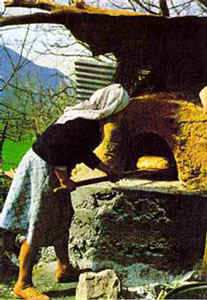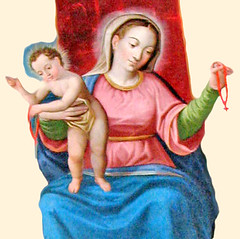Of leaven and lamps
However, we can also benefit from trying to understand better the very images and metaphors used by Jesus. A shepherd or a fisherman brings different insights into the Lord's use of these images which a banker in the City may not be able to appreciate. But I am not suggesting that we try our hand at these professions (unless of course you want to...). Farming is yet another frequent motif in the Scriptures and anyone who has planned, planted and coaxed a garden into flowering and fruition knows the patience, toil, labour and love required. Preparing my mother's new lawn in Germany a few years ago helped me to realise this!

But not everyone has a garden to tend (indeed they are rare in Singapore) so what else can one try? Bread-making is a splendidly therapeutic and satisfying experience which I would recommend. Indeed, I went to bed last night thinking about the need to get some bread from the supermarket and then decided, I should just make my own! Jamie Oliver is a great fan of bread-making and I can see why - it's fun, fairly simple and quite relaxing. The result is tastier than store-bought bread, more wholesome and healthful and something one can take pride in! But from a Christian point of view, there are wonderful lessons to be learnt too.
Yeast (or leaven) is added to the dough in order to help it to rise. Without it, the bread will not be light and fluffy. Once the dough has been kneaded with the leaven, one has to allow the yeast to respire and act. I find this in itself a rather miraculous thing - those dried spores in packets are alive and they are breathing, creating the bubbles of air which makes the dough rise! One could see in this a metaphor for Resurrection: life emerging from what seems life-less. This stage of bread-making which is called proving takes time. Some bakers recommend leaving the yeast to prove for two hours. No wonder the Israelites had to have unleavened bread on Passover night. As Exodus 12:39 clearly says: "They baked unleavened cakes of the dough... it was not leavened, because they were driven out of Egypt and could not wait."
In the time that it takes for the dough to rise, one can do nothing but wait, which brings us to that great leitmotif of waiting. We wait and allow the yeast to act, just as I we wait and allow God 's loving action to unfold in our lives... and God's action, like the yeast in the bread, is at first inperceptible but it soon swells up into something great. As such, Jesus likens the Kingdom of heaven to yeast in a mixture of flour. (cf Mt 13:33) So too, the bread when proven, will become at least twice its size. I watched in amazement as the dough seemed to be alive: I literally saw it move when the huge bubbles of air within pushed against the cling-film cover of the basin it was in. So too, great things happen in our lives if we allow God to do his work, to act in our lives, to be leaven to our dough: the leaven of love.
Only 20g of dried yeast is used in the recipe which calls for 700g of flour. And yet, this little bit of leaven spreads throughout the whole mixture and affects it so profoundly. No wonder that St Paul says: "A little yeast leavens the whole batch of dough" (Gal 5:9). What this suggests to me is that the witness of Christian love in society can be like that small bit of yeast that permeates throughout the dough of society and transforms it into something life-giving: bread. In fact, one can stretch the analogy further! Yeast is alive, as we Christians are with the life of the Risen Lord. The living yeast 'breathes' in the dough, causing air bubbles; the Holy Spirit has long been associated with breath, pneuma. This air causes the dough to rise and to become bread, just as Christians can transform society. In the process of being baked, the yeast is killed, their role now accomplished; this self-giving and self-sacrifice is the paradigm of Christian life, in the likeness of Christ...
And all this (and I am sure more to come!) just from baking a loaf of bread! And of course, one benefits from having a lovely meal out of it later on, as I shall tonight!

One final mention: another Biblical image I have tried is to burn olive oil lamps. Although these are still common in the Eastern churches, this practice is seldom seen in the West. Bearing in mind Christ's injunction: "Be dressed for action and have your lamps lit" (Lk 12:35) and the ancient liturgical precept of the Eternal lamp in the Temple (the 'Menorah') and the use of such olive-oil lamps or lampada as household lamps, I resolved to burn a perpetual light in front of an icon of Our Lady in my room. The Jewish perpetual lamp (still found in Synagogues, called the 'Tamid') is the ancestor of our Sanctuary lamp, which should still be of olive oil content. Olive oil has long had a special mystical significance in the Mediterranean.
Anyway... the olive oil lamp casts a beautiful golden glow in the room and gives off a wondrous fragrance of olives. The wick is of bees wax, itself having wonderful significance - perhaps more on these another day... But the lesson one learns in keeping a perpetual lamp alight is the need to be watchful, diligent and careful! A person of the ancient world who heard Christ speak of being ready and having lamps lit would know immediately what he meant. But for us, we need to actually try having such lamps, as this other blogger has, in order to fully appreciate the power of our Lord's imagery.
I fully recommend these practices to you, as a kind of lectio divina on every-day life! Recipes here...







0 Comments:
Post a Comment
<< Home